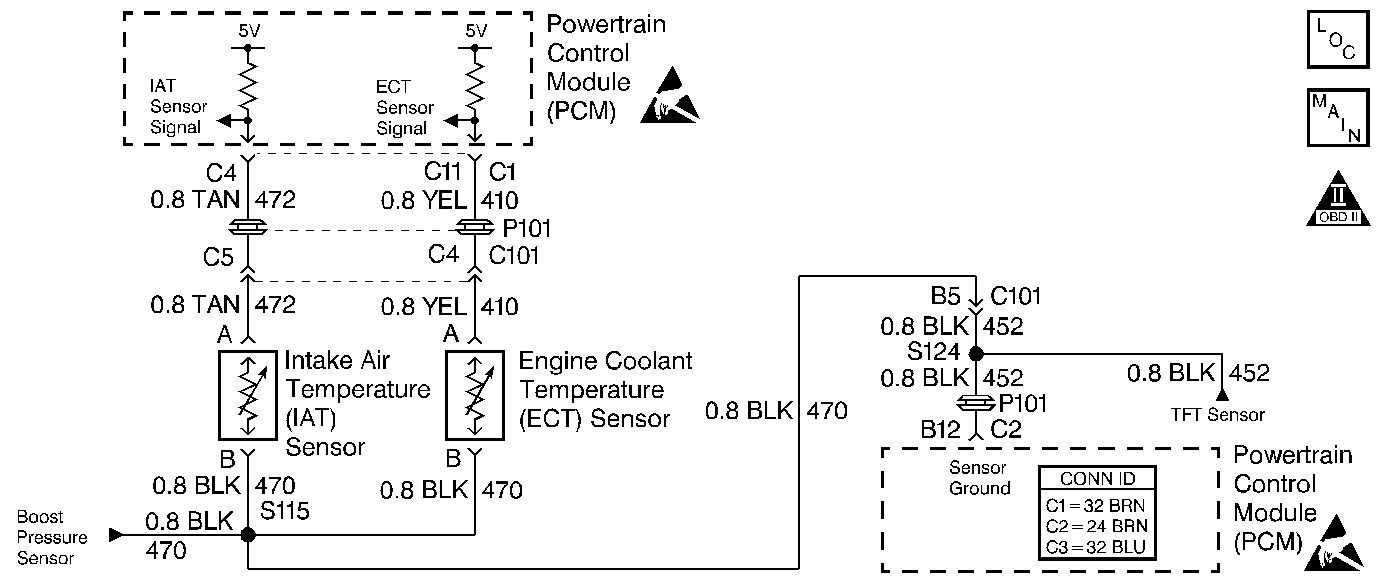
Circuit Description
The engine coolant temperature (ECT) sensor is a thermistor that controls the signal voltage to the PCM. When the engine is cold, the sensor resistance is high, therefore the PCM will see a high signal voltage. As the engine warms, the sensor resistance becomes less and the voltage drops. The voltage measured across the thermistor is interpreted as a temperature.
Conditions for Running the DTC
The engine has been operating for at least 8 minutes.
Conditions for Setting the DTC
| • | The ECT is less than -30°C (-22°F). |
| • | The conditions were met for 2 seconds. |
Action Taken When the DTC Sets
| • | The PCM illuminates the malfunction indicator lamp (MIL) on the second consecutive drive trip the diagnostic runs and fails. |
| • | The PCM records the operating conditions at the time the diagnostic fails. The first time the diagnostic fails, the Failure Records store this information. If the diagnostic reports a failure on the second consecutive drive trip, the Freeze Frame records the operating conditions at the time of failure and updates the Failure Records. |
Conditions for Clearing the MIL/DTC
| • | The PCM will turn the MIL off after 3 consecutive trips without a fault condition. |
| • | A History DTC clears after 40 consecutive warm-up cycles, if this or any other emission related diagnostic does not report any failures. |
Use a scan tool in order to clear the DTCs.
Diagnostic Aids
Check the harness routing for a potential short to voltage. After the engine is started, the ECT temperature should steadily increase to approximately 85°C (185°F). A mis-scaled sensor could result in poor driveability complaints.
Test Description
Numbers below refer to the step numbers on the Diagnostic Table.
-
This step determines if P0118 is a hard failure or an intermittent condition.
-
This step will determine if there is a wiring problem or a malfunctioning PCM.
-
This step determines if there is a short to voltage on the signal circuit. A short to voltage increases the current flow through the sensor, which overwhelms the sensor. This does not allow the sensor to pull down the circuit to the correct voltage and thus display the correct temperature.
-
After repairing the short to voltage, check the sensor for proper operation.
Step
| Action | Value(s) | Yes | No |
|---|---|---|---|---|
1 |
Important: Before clearing any DTCs, use the scan tool Capture Info function in order to save the Freeze Frame and Failure records for reference. The control module's data is deleted once the Clear Info function is used. Was the Powertrain On-Board Diagnostic (OBD) System Check performed? | -- | ||
Does the ECT display a temperature colder than or equal to the specified value? | -30°C (-22°F) | |||
Does the scan tool display an ECT temperature that is more than or equal to the specified value? | 151°C (303°F) | |||
4 | Jumper the ECT sensor signal circuit to a known good ground. Does the scan tool display an ECT temperature that is more than or equal to the specified value? | 151°C (303°F) | ||
5 | The DTC is intermittent. If no other DTCs are stored, refer to Diagnostic Aids. Are than any other DTCs stored? | -- | Go to the applicable DTC table | Go to Diagnostic Aids |
6 |
Did you perform a repair? | -- | ||
7 |
Did you perform a repair? | -- | ||
8 |
Did you perform a repair? | -- | ||
With a J 39200 set to the mA scale, measure the current at the ECT harness connector terminals. Is the current less than the specified value? | 48 mA | |||
Repair the short to voltage on the ECT signal circuit. Refer to Wiring Repairs in Wiring Systems. Is the action complete? | -- | -- | ||
11 | Inspect the PCM connectors for faulty connections and replace the terminals, if necessary. Refer to Wiring Repairs in Wiring Systems. Did you perform a repair? | -- | ||
12 | Replace the ECT sensor. Refer to Engine Coolant Temperature Sensor Replacement . Is the action complete? | -- | -- | |
13 |
Important: The new PCM must be programmed. Refer to Powertrain Control Module Replacement/Programming . Replace the PCM.Is the action complete? | -- | -- | |
14 |
Does the scan tool indicate the diagnostic Passed? | -- | ||
15 | Does the scan tool display any additional undiagnosed DTCs? | -- | Go to the applicable DTC table | System OK |
